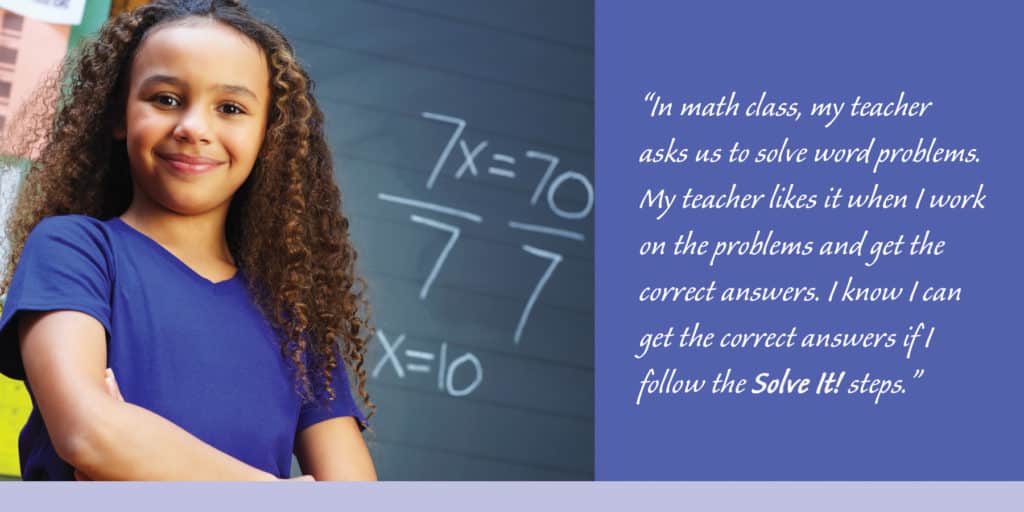Can Solve It! teach third graders math word problem solving? Exceptional Innovations frequently receives questions such as:
- “Can Solve It! Teach Third Graders Math Word Problem Solving?”
- “Is Solve It! effective for teaching math word problem solving in third and fourth grades?”
- “My third-grade students are having difficulty solving math word problems. Would Solve It! help them?”
Often these questions are related to meeting Common Core State Standards (CCSS). These standards identify math word problem solving in third grade. Standardized assessments in third grade also play a role because many include problems that require math word problem-solving skills.
The evidence base we have for Solve It! is with students in grades 5-12. However, because Solve It! is an instructional strategy, it might be adaptable for younger students. Above all, Solve It! does embed instructional strategies that research has linked to successful third grade math word problem-solving interventions. In that vein, this blog considers whether Solve It!l can be used with third students. First, let’s look at some recent research on the topic.
Math Word Problem-Solving Interventions for Third Graders—A Broad Look
Dr. Jennifer Krawec is the author of the Solve It! version for Grades 5-6. In 2016, she co-authored an article* that examined the instructional components and content identified as effective in teaching math word problem solving in third grade. The 13 quantitative studies met strict selection criteria. They used single subject, quasi-experimental, and randomized controlled trial designs.
In summary, the researchers found the following instructional practices to support the problem-solving process:
- Teacher-mediated explicit instruction with multiple exemplars that show students how to demonstrate understanding of the problem and how to solve it. For example, the problem-solving process is broken down into smaller steps. Teachers model the steps. Students engage in guided practice; they receive corrective and positive feedback that is immediate and specific. Prior to assessment, teachers give students ample time to practice solving math word problems.
- Visual representations to support concept formation and the ability to plan a viable solution approach. Teachers generate various visual models for solving problems. They avoid the use of templates.
- Self-strategies. These include self-monitoring and self-correcting to reflect on and check work. These strategies build confidence, independence, and generalization of the problem-solving strategy.
Can Solve It! Teach Third Graders Math Word Problem Solving?
So, can Solve It! teach third graders math word problem solving? First of all, the research-based practices are integral parts of the Solve It! approach. Solve It! uses explicit instruction to teach a 7-step cognitive process to solve math word problems. Furthermore, metacognitive strategies—say, ask, and check—are used at each step to self-monitor performance. Thus, from an instructional perspective, Solve It! has promise for addressing the math problem solving challenges that third grade students face. This is because the instructional practices found to benefit third graders mirror those in Solve It!

The Solve It! approach embeds research-based instructional practices for teaching third graders math word problem solving.
However, teachers will need to consider the cognitive readiness of their students in relation to performing the Solve It! steps. To use Solve It! with third grade students, teachers may find it necessary to accommodate developmental differences. Examples include:
- Checking reading level and age appropriateness of the word problems.
- Focusing on 1-step problems while learning the steps.
- Increasing the number of lessons to learn the seven steps. Expanding the number of practice sessions.
- Ensuring that students have mastered the mathematical operations required in the problems. If you limit initial instruction to addition and subtraction, you may find it helpful to reteach the Solve It! approach when introducing multiplication and division problems.
- Renaming the Solve It! steps, as necessary. For example, the “Visualize” step may be changed to “See the Story.” Instruct students in different ways to express the story by drawing, using manipulatives, etc.
- Teaching the skill required in a step. In some cases, expand instruction on how to do the step. For example, estimating (Step 5) is a higher level skill. It requires students to conceptualize and mentally manipulate numbers, which may be challenging for some 8 year olds.
Summary
To sum up, teachers may find that they can successfully individualize and differentiate Solve It! instruction for third grade students. Even more, Solve It! may help teachers understand the steps that good problem solvers use to solve math word problems. They can use this knowledge when troubleshooting student difficulties.
Learn More About Solve It!
 Learn more about Solve It! at https://www.exinn.net/solve-it/
Learn more about Solve It! at https://www.exinn.net/solve-it/
Solve It! processes align with the CCSS https://www.exinn.net/wp-content/uploads/2015/10/Krawec-and-Warger-CCSS-Alignment-w-Solve-It1.pdf Solve It! also aligns with standards in states that have not adopted CCSS (Alaska, Indiana, Minnesota, Nebraska, Oklahoma, Texas , Virginia). Check out the links at the end of the “Details” page at https://www.exinn.net/solve-it-third-edition/
Reference
* Kingsdorf, S., & Krawec, J. (2016). A broad look at the literature on math word problem-solving interventions for third graders. Cogent Education, 3, https://www.cogentoa.com/article/10.1080/2331186X.2015.1135770
